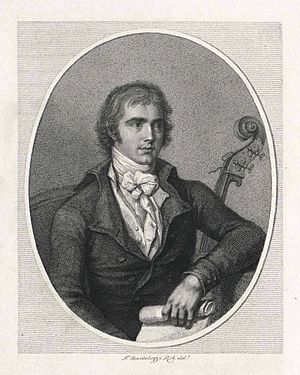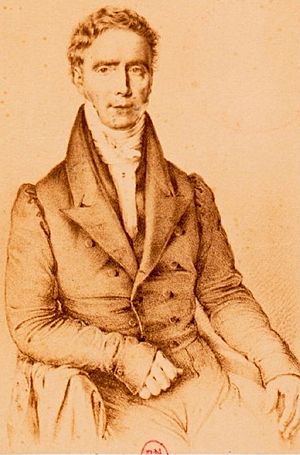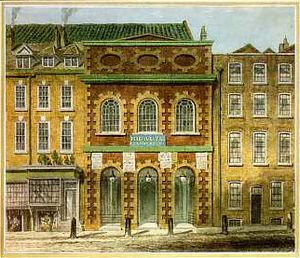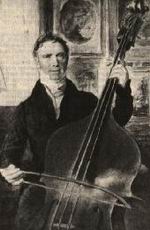Domenico Dragonetti facts for kids
Quick facts for kids
Domenico Dragonetti
|
|
|---|---|
 |
|
| Background information | |
| Birth name | Domenico Carlo Maria Dragonetti |
| Born | 7 April 1763 Venice, Italy |
| Died | 16 April 1846 (age 83) London, England |
| Genres | Classical |
| Occupation(s) | Composer, double bassist, pedagogue |
| Instruments | Double bass |
| Years active | 1790–1846 |
Domenico Carlo Maria Dragonetti (born April 7, 1763 – died April 16, 1846) was an amazing Italian double bass player and composer. He was known as a "virtuoso," which means he was incredibly skilled at playing his instrument. He even used a special three-string double bass!
Domenico spent 30 years in his hometown of Venice, Italy. He played in various famous places, like the Opera Buffa and the Chapel of San Marco. He became so famous across Europe that he turned down offers from the Tsar of Russia!
In 1794, he moved to London to play in the orchestra at the King's Theatre. He stayed there for the rest of his life. For 50 years, he was a very important person in London's music scene. He performed at big concerts and private events, meeting powerful people like the Prince Consort.
Domenico was friends with famous composers like Joseph Haydn and Ludwig van Beethoven. He visited Beethoven in Vienna several times. He showed them how the double bass could be a solo instrument, not just part of the orchestra. Because of him, composers started writing separate music for the double bass, instead of just having it play the same notes as the cello. He also created the "Dragonetti bow," which is still remembered today.
Contents
Domenico's Early Life in Venice (1763-1794)
Domenico Dragonetti was born in Venice, Italy. His father, Pietro, was a barber and loved music. Domenico started playing the guitar and double bass by himself, using his father's instruments.
A violinist named Doretti quickly noticed Domenico's talent. Doretti was a composer of dance music and took Domenico to play in public shows in Venice. When Domenico was just 12 years old, he began lessons with Berini, Venice's best double bass teacher. After only 11 lessons, Berini said he couldn't teach Domenico anything more!
At 13, Domenico became the main double bass player at the Opera Buffa in Venice. A year later, he was the main double bass player at the Grand Opera Seria at the San Benedetto theatre.
When he was about 18, Domenico joined a music group in Treviso. A powerful person, Morosini, heard him play and invited him to try out for the Chapel of San Marco. Domenico joined this important music group on September 13, 1787. He quickly became the main double bassist there. He even turned down an offer from the Tsar of Russia, which made the chapel give him a raise!
Domenico became very famous. He started playing solo pieces, which was very unusual for the double bass back then. He even helped organize a music festival for 14 visiting princes. The queen of Naples especially loved one of his concertos.
While in Vicenza, Domenico got his famous Gasparo da Salò double bass. This special instrument is now in the museum at St Mark's Basilica. He turned down another offer from the Tsar, and in return, the leaders of St Mark's gave him an even bigger raise. They also let him take a year off to go to London, still paying him. This leave was extended, and Domenico never truly returned to Venice for long.
Domenico didn't have a close family of his own. But he had many good friends in the music world in London. He loved collecting things, including dolls. He sometimes took a doll with him on trips to make children happy, as he was very fond of kids. Domenico never learned to speak English perfectly. He spoke a mix of Italian, English, French, and Venetian. But he was very smart with money and helped his family in Venice.
Life in London (1794-1846)
Domenico left Venice on September 16, 1794. His friend, Giovanni Battista Cimador, helped convince him to go. He started rehearsing at the King's Theatre in London on October 20, 1794. His first public performance there was on December 20, 1794, in an opera called Zenobia in Palmira. In just a few months, he became very famous in London, and his amazing career continued until he died.
He became close friends with important people like the Prince Consort and the Duke of Leinster. Between 1816 and 1842, he played in 46 concerts for the Philharmonic Society of London.
At the Italian Opera orchestra, he met the cellist Robert Lindley. They became very close friends and played together for 52 years! They were especially good at playing Arcangelo Corelli's sonatas.
When he was 82, Domenico visited Bonn in August 1845. He went to a three-day music festival to celebrate the opening of the Beethoven Monument. Famous musicians like Louis Spohr and Franz Liszt conducted Beethoven's works there.
Domenico Dragonetti died in London when he was 83. He was buried on April 23, 1846. Later, in 1889, his remains were moved to a cemetery in Wembley.
Vincent Novello and Count Carlo Pepoli were some of his most famous friends in London.
Domenico's Visits to Vienna
In 1794, Joseph Haydn visited England for the second time. Haydn met Dragonetti and they became very good friends. Dragonetti visited Haydn in Vienna in 1799. On that first trip to Vienna, Dragonetti also met the famous composer Ludwig van Beethoven.
Here's a famous story about their meeting: "Beethoven had heard that his new friend could play cello music on his huge double bass. One morning, when Dragonetti visited, Beethoven wanted to hear him play a sonata. Dragonetti's double bass was brought, and they chose Beethoven's Sonata, n°2, of Op.5. Beethoven played his part, watching Dragonetti closely. In the last part, where there are fast arpeggios, Beethoven was so excited and happy that he jumped up and hugged both Dragonetti and his instrument!" (Alexander Wheelock Thayer, 1867)
This meeting showed Beethoven how amazing the double bass could be. Even today, playing Beethoven's double bass parts in symphonies is a basic skill for all orchestra double bass players.
Dragonetti returned to Vienna for a long stay in 1808-1809. On this trip, he became friends with composer Simon Sechter. Sechter later became a court organist and a music professor. He wrote piano parts for some of Dragonetti's concert pieces, and they wrote letters to each other for many years.
Dragonetti was in Vienna again in 1813. He met Beethoven once more, who had just written Wellington's Victory. This piece celebrated the victory of Wellington over the French army. The first performance of Wellington's Victory and Beethoven's Seventh Symphony happened on December 8, 1813. Dragonetti led the double bass section in that performance.
Domenico's Playing Style
Dragonetti was known for his incredible strength and endurance. This was very important because, back then, the double bass helped the orchestra leader keep the music together and set the speed.
He had large hands with strong, wide fingers. This allowed him to play with a higher bridge and strings that were twice as far from the fingerboard as other bassists. This was very unusual at the time. Most players used only one finger for one note in a position, or used three fingers together. But Dragonetti used all five of his long, strong fingers to play notes up and down the fingerboard.
Domenico's Amazing Instrument Collection
Dragonetti loved art and collected many things. He collected musical instruments, original music scores, and paintings. When he passed away, his collection included many valuable instruments:
- A giant double bass thought to be made by Gasparo da Salò. This instrument is now in the Victoria and Albert Museum in London.
- A beautiful Domenico Montagnana Basso di Camera from Venice.
- Another Gasparo da Salò double bass from 1590.
- An Amati double bass.
- A Maggini double bass.
- A Stradivarius violin (once played by Paganini), now called the "Dragonetti" violin.
- A Guarnerius "del Gesù" violin from 1742, now known as the "Dragonetti-Walton" violin.
- A Gasparo da Salò violin.
- Two Amati violins.
- One Lafont violin.
- A copy of a Stradivarius violin.
- 26 unnamed violins.
- A Gasparo da Salò viola.
- An Amati viola.
- A Hill viola.
- 5 unnamed violas.
- 6 cellos.
- A large cello.
- 3 guitars.
- 2 bassoons.
- 3 French horns.
One story says that Dragonetti received his famous Gasparo da Salò bass from Benedictine nuns in Vicenza. This was after he turned down offers to play in London and Moscow. The leaders of St Mark's in Venice wanted him to stay, so they gave him money and this special instrument.
Domenico's Music
When Dragonetti moved to London in 1795, he left many of his papers and music behind with a friend. These included a "Complete system of the double bass," which had many exercises and studies. Sadly, these papers were sold, and he couldn't get them back.
Today, many of his letters, personal papers, and music pieces are kept in the British Library. Some were given by Dragonetti himself, some by his friend Vincent Novello, and others were bought at auctions.
Some of the music Domenico Dragonetti composed includes:
- Adagio and Rondo in A major, for double bass and orchestra.
- Andante and Rondo, for double bass and strings.
- Concerto no. 5 in A major, for double bass and orchestra.
- Grande Alegro for Double bass and strings.
- Menuet and Alegro for double bass and piano.
- Sonata for double bass and piano.
- Allegretto for double bass and piano.
- Famous solo in E minor for double bass and piano.
- Adagio and Rondo in C major for double bass and piano.
- Concerto in G major (Andante, Alegretto) for double bass and orchestra.
- Serenata, for piano and string bass.
- Solo in D major, for double bass and piano.
- Pezzo Di Concerto.
- Twelve Waltzes for solo double bass.
There is also a "Concerto in A major for string bass and orchestra." It is now believed that this piece was actually written by Edouard Nanny as a tribute to Dragonetti.
Images for kids
See also
 In Spanish: Domenico Dragonetti para niños
In Spanish: Domenico Dragonetti para niños





